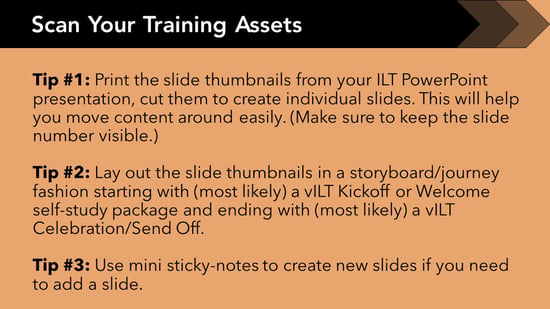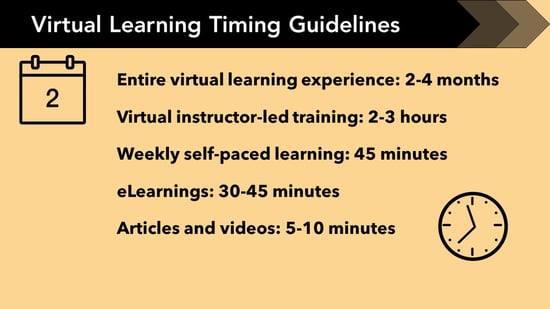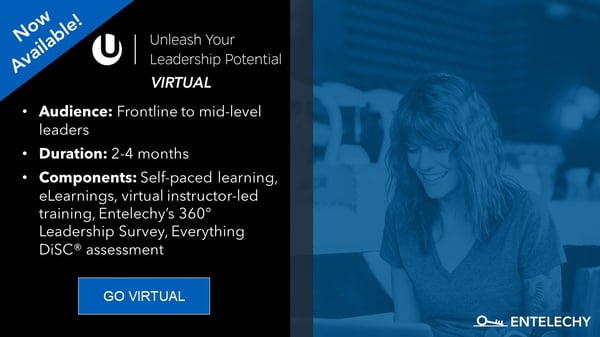Have you ever left a training session (virtual or otherwise) and thought, "What even was the point of that?" or "What am I supposed to do now?" Unfortunately, you're not alone. In today's increasingly virtual working world, virtual learning opportunities are quickly filling our calendars — but to what end?
Our experience tells us that the most engaging and impactful training is fully supported by a thoughtful, carefully curated learning journey that ties back to the learner's (and the organization's) goals. This is not training for training's sake, but rather a comprehensive learning experience designed to ultimately change behavior and drive results.
So, what exactly is a learning journey?
Simply put, a learning journey is a multi-event learning experience that happens over a set period of time. With a learning journey, participants can see the full path at the outset so they know exactly what is expected of them every step of the way. Going beyond a one-time training event, a learning journey contains multiple check-points and supporting activities to build out the experience. Along the way, learners typically have the opportunity to practice their new skills, share their progress with team members, reflect on key learning points, and set goals for the future.
As you plan for your next training initiative, ask yourself this question: "What is the intention of this training?" Are you exploring a weighty topic (like leadership) best discussed over a length of time? If so, a learning journey is for you. If, however, you are training employees on a new software platform or company policy, you can likely forgo the journey and aim for a one-time training event, like a webinar or a video tutorial.
Okay, so now that you've decided to leverage a learning journey, what's next? In this article, we'll outline six steps to creating a powerful virtual learning journey.
1. Scan Your Training Assets
 Make a list of everything you have access to that supports your particular topic. Training assets can include things like virtual instructor-led training (vILT) sessions, eLearnings, articles, videos, TED Talks, self-assessments, meetings with managers, reinforcement activities, assignments, facilitator-guided discussions, and so much more.
Make a list of everything you have access to that supports your particular topic. Training assets can include things like virtual instructor-led training (vILT) sessions, eLearnings, articles, videos, TED Talks, self-assessments, meetings with managers, reinforcement activities, assignments, facilitator-guided discussions, and so much more.
If you previously conducted face-to-face training, you'll need to consider how to make it virtual. For example, most of our face-to-face training begins with a presentation and moves towards interactive stuff like discussion and activities. The presentation portions of our training can be turned into asynchronous self-study or eLearning; we can do the interactive stuff more effectively using asynchronous social learning or a virtual instructor-led training (vILT). Figure out what works best for your particular training and learning environment.
2. Establish a Place to House Everything
In order to maximize engagement and set learners up for success, you'll need one central location to put everything. This way, participants can clearly see what's expected of them along the way and prepare for activities effectively. Having a central repository also eliminates excuses for not receiving a reminder email or not being able to access a particular file.
A social learning platform like NovoEd provides a one-stop shop for all resources, instructions, and conversations related to a given learning journey. If you're not able to use a social learning platform, you can leverage what you do have (Microsoft Teams, for instance, or Yammer, slightly less effectively) to structure the journey. Lately, we've been tasked with using Microsoft Teams as the main hub for information related to the program. It's where learners can find housekeeping rules, logistics, technology tutorials, the complete journey map, prework, downloadable resources, and discussions.
3. Determine the Duration of Your Journey
How long would you like learners to engage in this work? What is realistic based on participants' schedules and your organization's culture? We've done a wide range of timelines over the years and find 2-4 months to be the sweet spot for most blended learning experiences. That allows for several live training events (vILTs or classroom session) as well as plenty of prework, self-reflection, and self-paced learning (eLearnings, videos, articles, etc.) without overwhelming the learner since they will still have their day jobs taking up most of their time. That timeline can stretch a bit longer if you're leveraging a social learning platform like NovoEd, which allows for increased social engagement and peer collaboration.
4. Outline a Rough Plan
 Now that you know what training assets you want to feature, you can begin sketching out a rough outline of how learners will engage with specific materials over time. When creating a plan, you need to think in chunks. You won’t have the captive audience you have with classroom training; each element of your program must be engaging on its own and shorter is always more engaging than longer. Participants will have busy schedules already so it's important that the program not take up too much of their time. We find that 45 minutes of self-paced learning, group collaboration, and/or assignments is a good amount; this allows ample time to dive into a particular topic without being too much of a burden. eLearnings should be 30-45 minutes tops. Videos and articles should take 5-10 minutes to digest.
Now that you know what training assets you want to feature, you can begin sketching out a rough outline of how learners will engage with specific materials over time. When creating a plan, you need to think in chunks. You won’t have the captive audience you have with classroom training; each element of your program must be engaging on its own and shorter is always more engaging than longer. Participants will have busy schedules already so it's important that the program not take up too much of their time. We find that 45 minutes of self-paced learning, group collaboration, and/or assignments is a good amount; this allows ample time to dive into a particular topic without being too much of a burden. eLearnings should be 30-45 minutes tops. Videos and articles should take 5-10 minutes to digest.
For vILTs, we've had success with two- and three-hour sessions. Any shorter than that and you're not allowing enough time to really unpack an issue and practice what you're teaching; any longer than that and you lose people. We realize the typical webinar or Zoom call is 60 minutes — maybe 90 minutes, tops — but virtual learning goes way beyond just listening to someone talk over PowerPoint slides. You need to build in frequent participant engagement and input — every five minutes or so — and you have to use a wide variety of different activities to include learners of all types and personalities. (For more vILT tips and best practices, be sure to read our article Take Your Instructor-Led Training VIRTUAL in Seven Steps.)
5. Fill in the Holes
Go back through your asset list and your training plan and see what's missing. Are there any key topics you weren't able to address with your currently available assets? Can you quickly create something from scratch or leverage an existing content license you might have to fill the gap? Likewise, were you able to effectively and thoughtfully use the key assets you hoped you would at the outset? Is there a good mix of content types? Are you giving people ample time to work through the learning and complete assignments? Are your vILTs or classroom sessions book-ended by meaningful prework and reinforcement activities? Does every engagement opportunity serve a purpose? Is there an overarching narrative throughout the program? Are learners marching toward a clear set of objectives and key takeaways?
6. Launch (and be Ready to Revise on the Fly)
Now you're ready to launch your virtual learning experience! No matter how hard you plan, there will always be room for improvements so don't be afraid to tweak the program as you go — especially if you're rolling the program out to multiple cohorts on a staggered schedule. There have been several instances where we've learned critical lessons about what works and what doesn't with the first cohort that we've leveraged for future cohorts. One of the many benefits of a social learning platform like NovoEd is that it's very easy to clone a learning environment and then make edits before launching again. With all blended learning experiences, it's essential to have master trainers who can be super flexible and adjust in real-time.
Final Thoughts
Virtual learning is here to stay. Virtual learning can be so much more than a one-off webinar or eLearning. In order to maximize the power of virtual and blended learning, we need to be more mindful and deliberate in mapping out learning journeys for our participants. Doing so will increase engagement throughout the program and drive real behavior change afterwards.
Now Available: Unleash Your Leadership Potential-Virtual
Our flagship leadership development program targeted at frontline and mid-level leaders is now available 100% virtually. Learn more and contact us to discuss how we can best meet your organization's unique needs during these unprecedented times.

